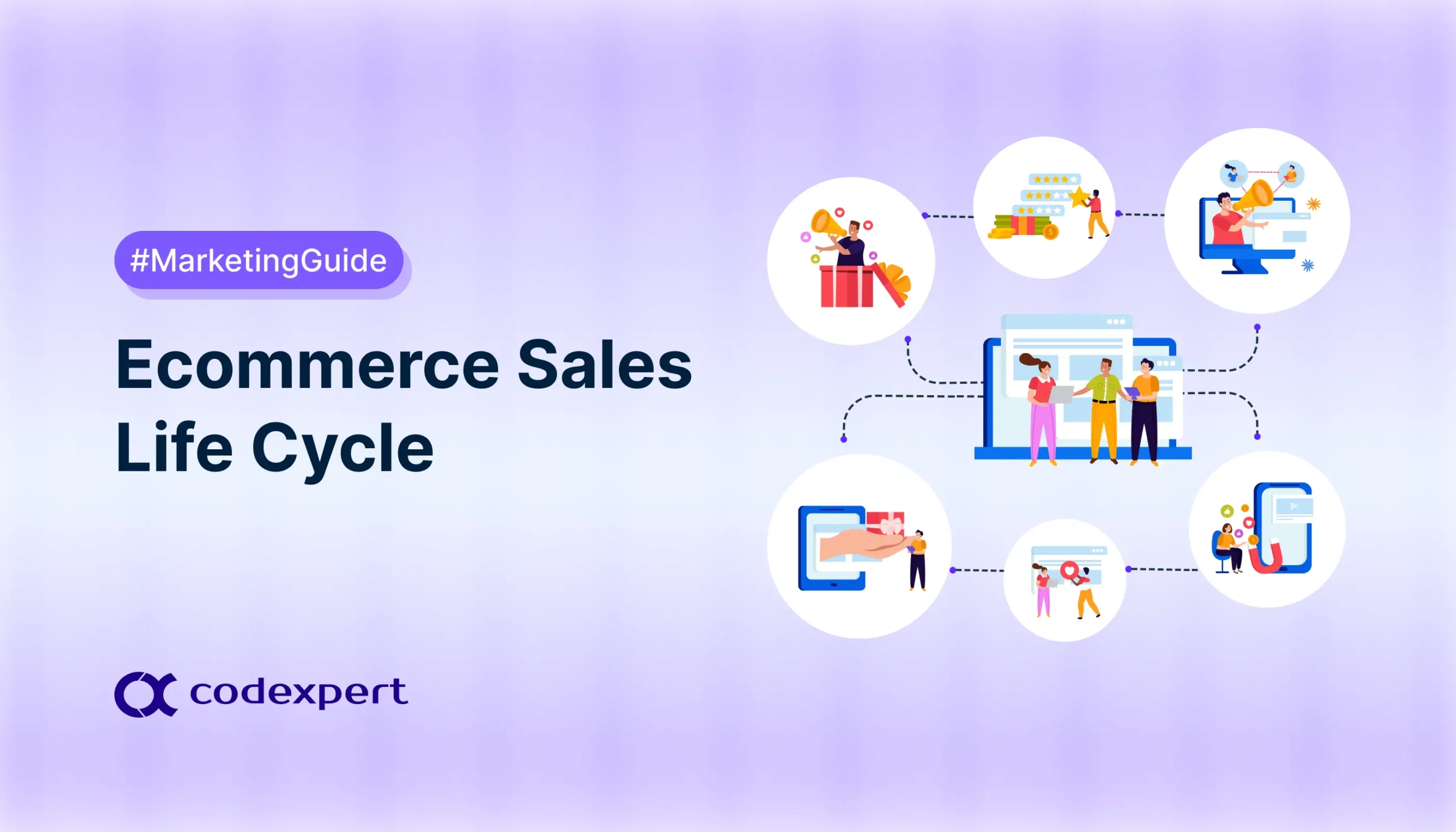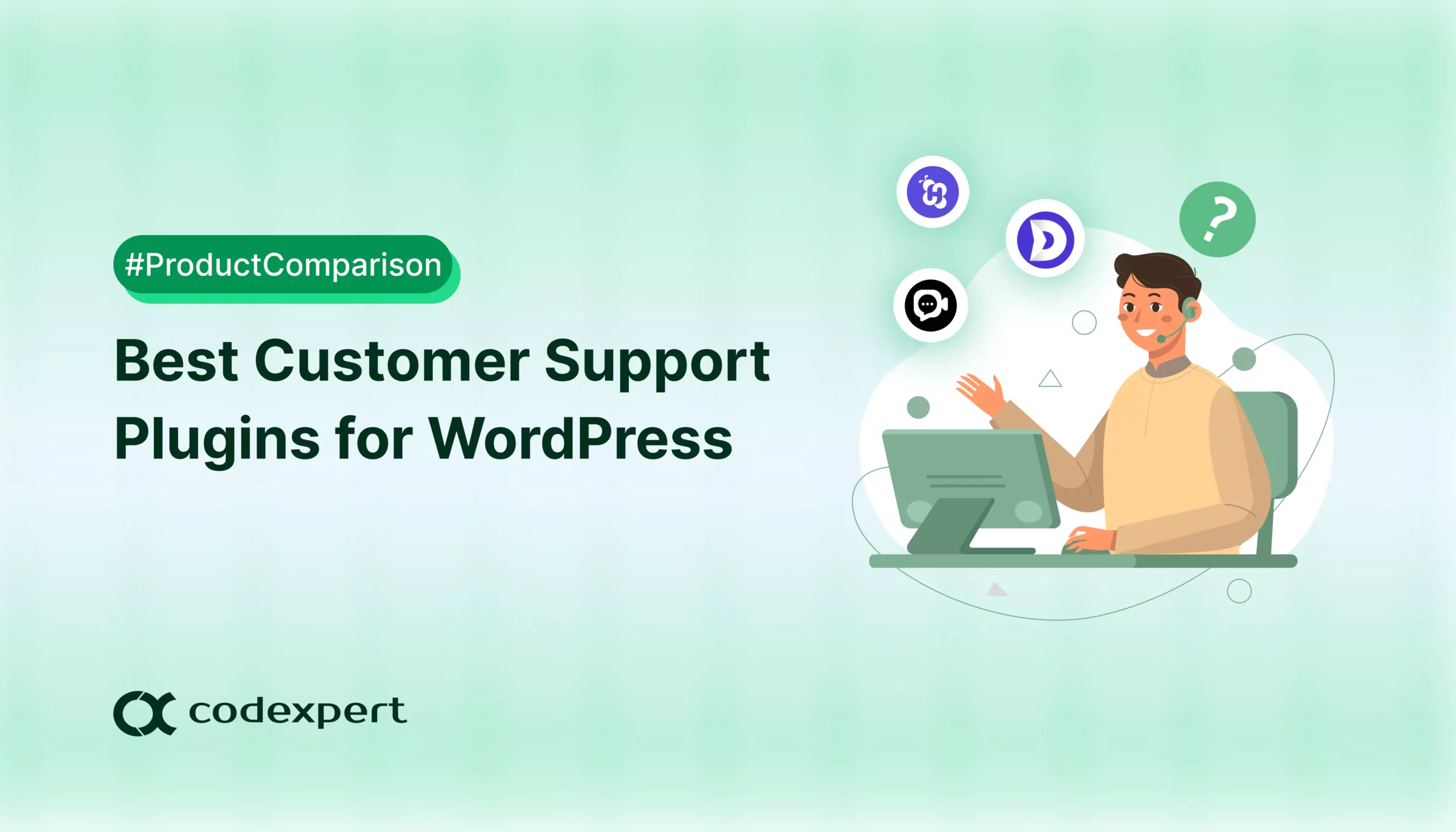30+ Insightful Cart Abandonment Statistics to Improve Sales in 2025
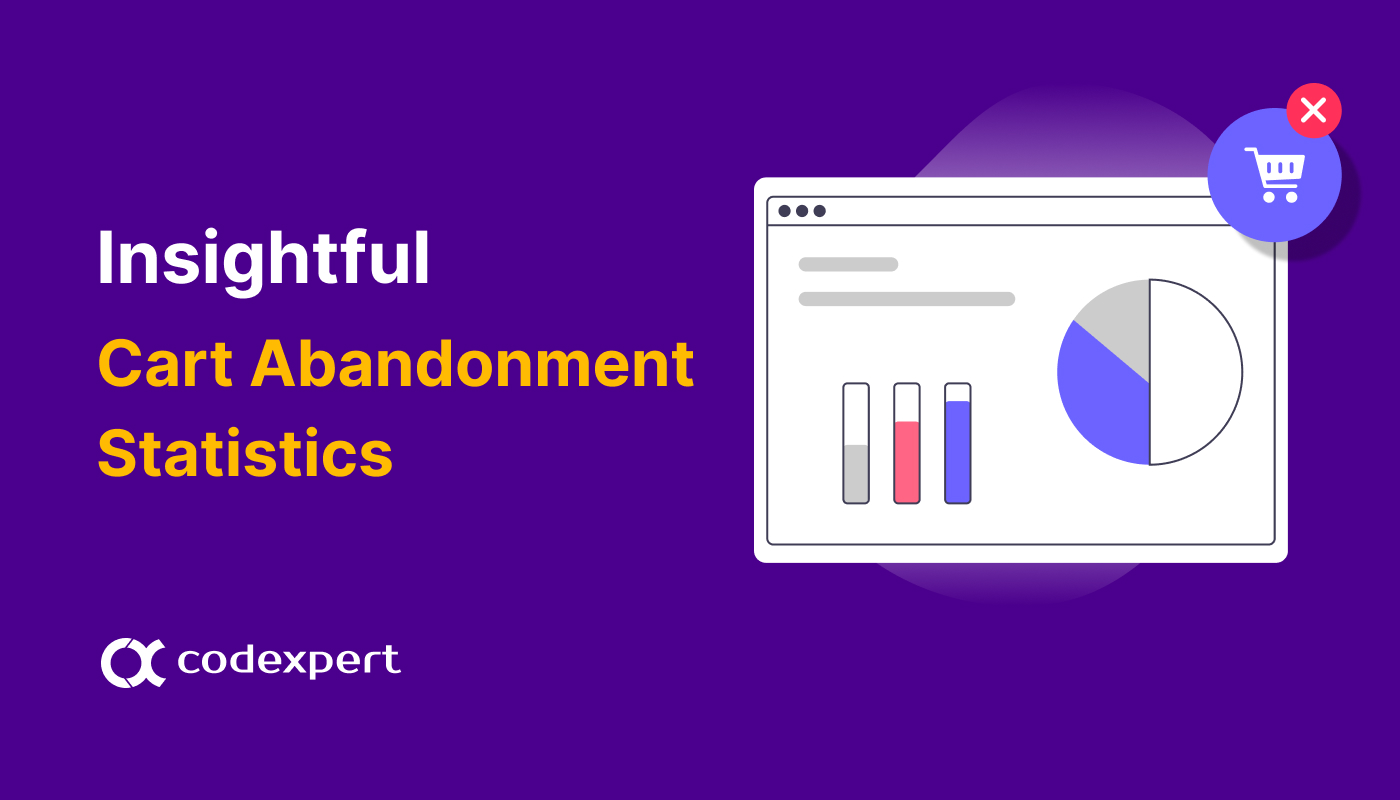
Shopping cart abandonment remains a significant challenge for eCommerce businesses worldwide. In 2025, understanding the factors behind cart abandonment with the right data driven strategies to combat it is essential for maximizing conversations.
In this article, we have 30+ insightful cart abandonment statistics that will shed light on customer behavior and can help you fine tune your sales strategies this year. Let’s dive into it!
Why Cart Abandonment Matters for Online Retailers
Cart abandonment is a critical issue for online retailers, as it reflects many potentials in shopping experience. Here’s why it matters:
Impact of Cart Abandonment in Revenue
Every abandoned cart directly affects potential revenue, translating to billions lost industry wide. In 2024, with increased competition and higher digital ad costs, each missed sale has a compounding effect. Cart abandonment doesn’t just mean a lost sale, it represents lost customer acquisition investment, reducing ROI on marketing spend. Plus, the long-term Customer Lifetime Value (CLV) takes a hit since fewer new customers convert into repeat buyers.
E-commerce Shopping Behavior Trends and Their Importance
Rise in Mobile Shopping: More shoppers rely on mobile devices, but limited screen space and sometimes-clunky mobile UX can lead to higher abandonment rates. Ensuring a user-friendly mobile experience is key to reducing cart abandonment.
Increased Customer Expectations for Convenience and Speed: Modern shoppers expect fast and friction-less checkouts and multiple payment options, including digital wallets and buy now, pay later (BNLP) options. Retailers who address these demands get better conversion.
Personalization and Targeted Marketing: With advancements in AI and analytics, personalized reminders and tailored offers have become the norm. Reaching customers with the right message at the right time, based on their shopping behavior, can help reduce cart abandonment.
Inflation and Budget-conscious Shoppers: Economic pressures have made consumers more cautious, often comparing prices before committing. Offering transparent pricing, flexible payments options, and personalized incentives can help overcome hesitation.
Key Cart Abandonment Statistics to Watch in 2024
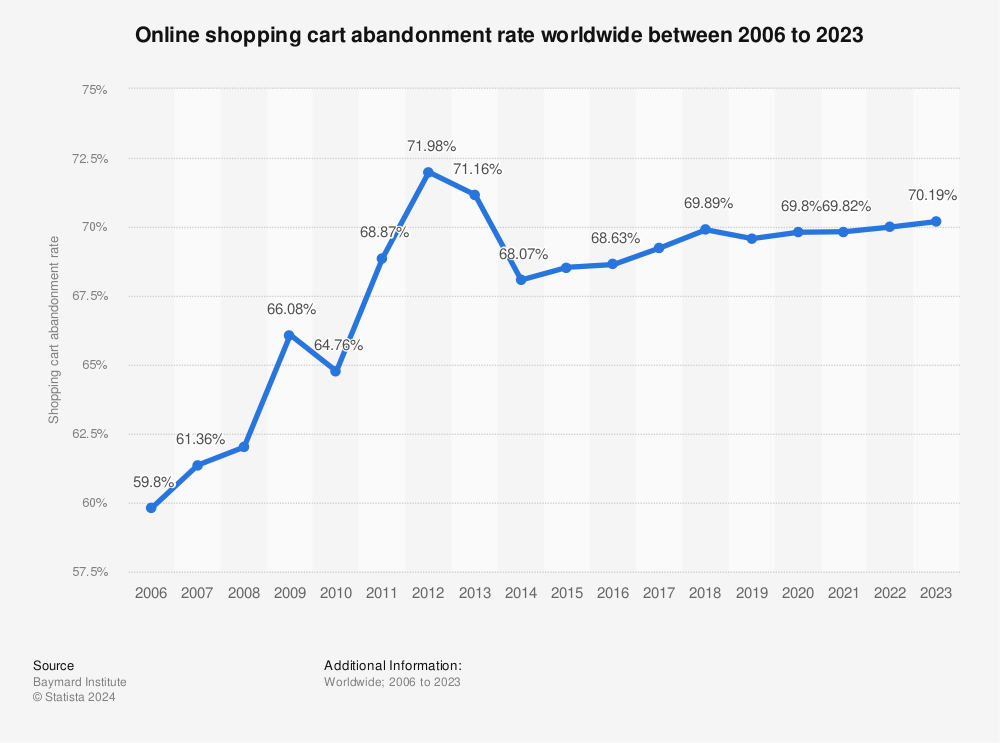
Find more statistics at Statista
General Cart Abandonment Stats
Average cart abandonment rate: According to Baymard The global cart abandonment rate hovers around 70.1%, meaning 7 out of 10 shoppers leave their cart without making a purchase.
Mobile Specific Abandonment Insights
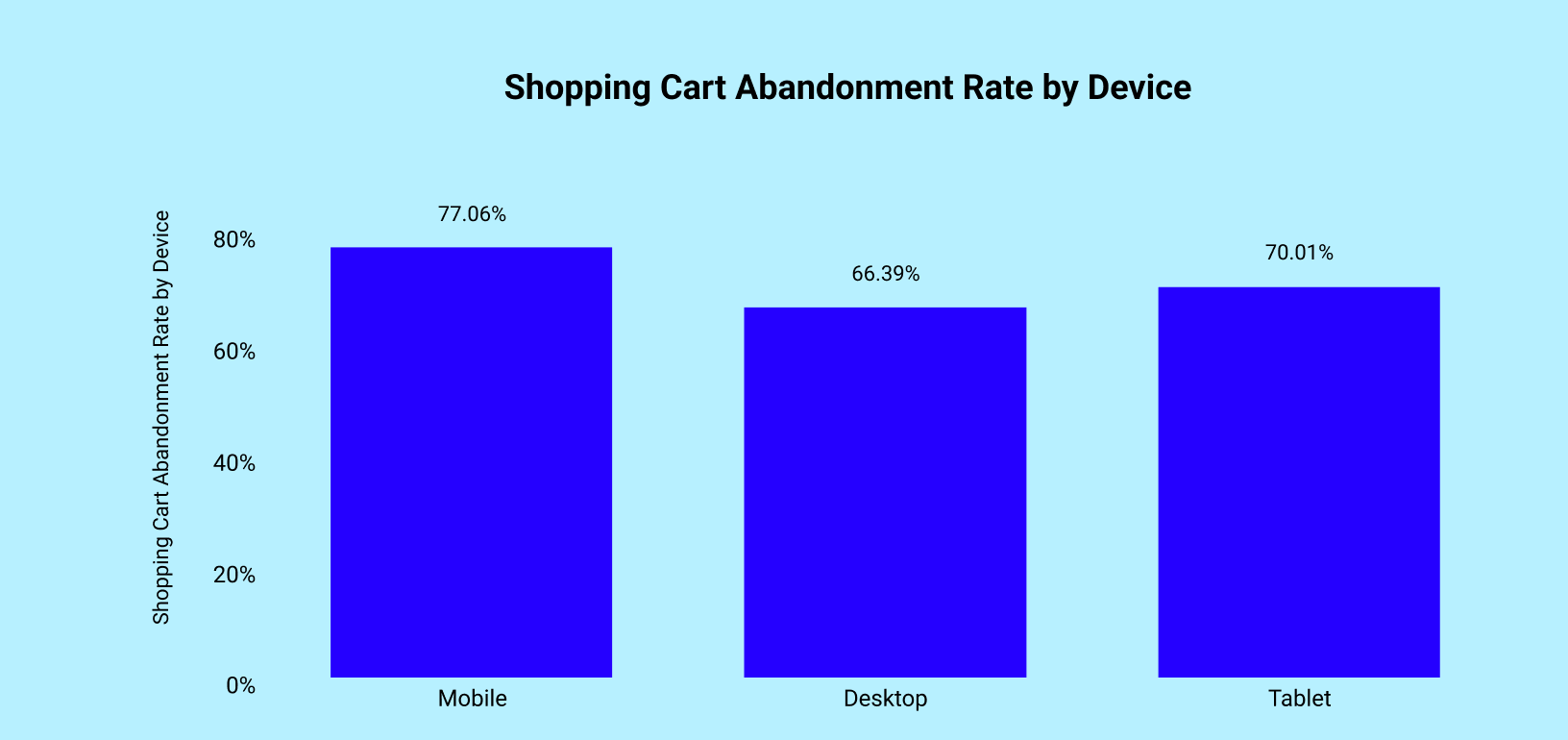
Source: Dynamic Yield
For devices cart abandonment rates vary for different devices. This number for mobile is 77.06%, for tablets 66.39%, and for desktop it’s only 70.01%.
Slow mobile sites: 53% of mobile users abandon a site if it takes longer than 3 seconds to load.
User friendly checkout: Businesses with an optimized mobile checkout see a 10% boost in mobile conversion rates. (Baymard UX Benchmark)
Cart saving reminders: 45% of mobile users appreciate reminders that their cart items are still available. (Moosend)
Industry Cart Abandonment Rate
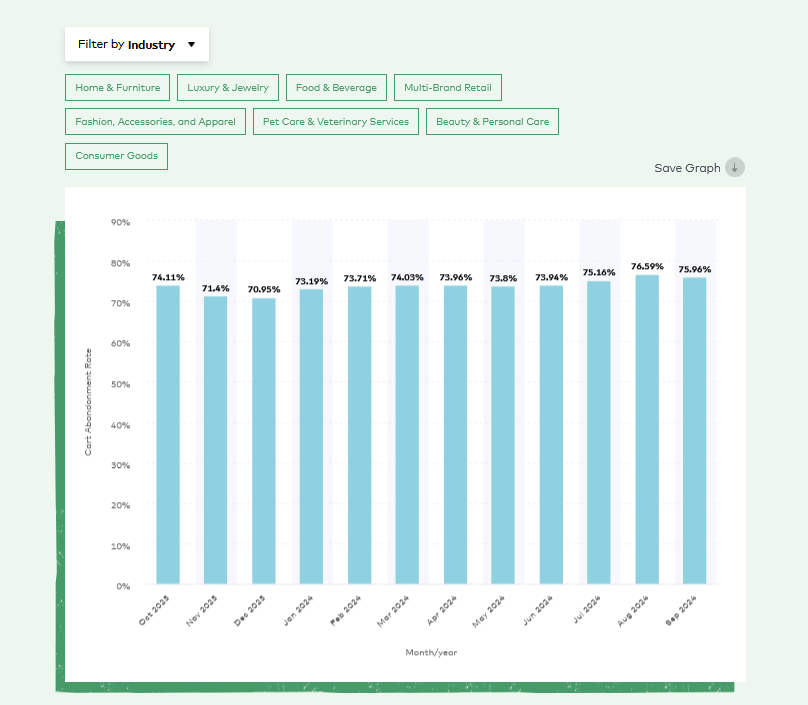
Source: Dynamic Yield
Industry-Specific Rates: Travel and finance industries report the highest abandonment rates, nearing 80% on average. While retail and fashion report lower 60-70%. (Dynamic Yield)
Manufacturing: In industry, high abandonment rates of around 81% are common due to the complex product configurations and lengthy approval processes. (FormStory)
Wholesale Distribution: With a 76% average abandonment rate, wholesalers often face issues from limited online pricing transparency and lack of payment options. (Baymard)
Technology and Software: The abandonment rate hovers around 70%, largely due to long sales cycles, complex product bundling and extensive research phases. (Wisernotify)
Healthcare and Pharmaceuticals: For this sector, abandonment rates reach up to 84% due to regulatory requirements and multi-layered approvals before purchases can be finalized. (BrightInsight)
Cart Abandonment Rate by E-mail
Open Rate: Cart abandonment emails have an average open rate of 39.07% indicating strong engagement with customers who may still be interested. (WPBeginner)
Click Through Rate (CTR): The CTR for cart recovery emails averages 21%, showcasing their effectiveness in driving users back to complete their purchase. (Convertkit)
Conversion Rate: Approximately 10% of shoppers who receive an abandonment email go on to complete purchase, making this one of the most effective recovery methods. (Hubspot)
Average Revenue Recovery
Potential Recovery Rate: Studies show that a strategic recovery process can bring back around 10-15% of lost revenue. (Primer)
High-Performing Recovery: Ecommerce sites that optimize their cart abandonment strategy with automated emails, retargeting ads, and discounts can recover up to 20% of potential lost revenue.
Impact of personalization: Personalized recovery emails can boost recovered revenue by 5-10%, as they better engage customers with tailored offers.
Key Cart Abandonment Factors – Complexity to Conversion
Abandonment and Checkout Complexity
Abandonment Due to Complexity: 22% of shoppers abandon their carts due to a lengthy or confusing checkout process. Users get lost and finally abandon their cart. (Baymard)
Checkout Steps and Conversion: Reducing checkout steps to three or fewer can increase conversions by up to 20%.
Guest-Checkout Preferences: According to Drip, 34% of customers abandon their cart when forced to create an account. Offering guest checkout options can significantly reduce this drop-off rate.
Lack of Payment Options
Cart Abandonment Due to Payment Issues: 13% of shoppers abandon their carts because their preferred payment option is unavailable. (PayPal)
Improved Conversion with flexible payment: Adding multiple payment methods, like digital wallets (Apple Pay, Google Pay), can boost conversion rates by 20%. (BigCommerce)
Impact of Buy Now, Pay Later: Offering “Buy Now, Pay Later” options has shown to reduce abandonment and increase conversion by up to 35% of higher ticket items. (Shopify)
Massive Shipping Cost
High Shipping cost: 48% of shoppers abandon their cart due to unexpectedly high shipping fees at checkout. (Baymard, 2024)
Free Shipping: Offering free shipping can reduce cart abandonment by as much as 18%, and customers are 88% more likely to complete their purchase when they see free shipping options. (Shoptimized)
Hidden Fees: 48% of Shoppers abandon their cart when they see additional fees (like shipping or taxes) during checkout, which weren’t disclosed earlier in the process. (Hotjar)
Lack of Guest Checkout
Account Creation Requirement: Approximately 245 of shoppers abandon their carts when they’re forced to create an account before completing their purchase, according to Baymard institute.
Guest Checkout Effect: Offering a guest checkout option can reduce abandonment by up to 30% and increase conversion by 10% or more, as many customers prefer not to register for an account.
Account Convenience: Studies show that 43% of users say guest checkout provides the convenience they prefer, making them more likely to complete the transaction. (Forbes)
Social Poof Effect
Influence on Purchase Decisions: BrightLocal reports that 88% of consumers trust online reviews as much as personal recommendation, and 40% feel more confident purchasing when they see customer reviews.
Impact on Cart Abandonment: Adding social proof elements, like customer reviews and trust badges, can reduce abandonment rates by 18%, as users feel reassured by others’ positive experiences. (Wisernotify)
Power of Visual Testimonials: Sites that include visual testimonials( photos, video reviews) see up to a 12% increase in conversion, as shoppers find visual proof more persuasive and trustworthy.
Impact of Loading Speed
Bounce Rate and Speed: A one second delay in page load time can reduce conversions by 7%, according to Akamai and Google research.
Abandonment Rate on Mobile: Around 53% of mobile users abandon a site if it takes longer than three seconds to load. This shows the importance of speed for retaining mobile shoppers. (Marketingdive)
Faster Site, Higher Conversions: Ecommerce sites that reduce load time from six to three seconds, see up to a 15% improvement in conversion rates, as many users find faster sites more convenient and reliable. (Hubspot)
7 Tips to Prevent Your Cart Abandonment
Here are some simple, effective tips to prevent cart abandonment and import your sales:
Keep Checkout Quick and Easy: Reduce the number of steps in your checkout to make sure it becomes fast and painless. Let people checkout as a guest without forcing account creation.
Offer Different Payment Options: Make it easy by offering popular options like credit cards, PayPal, and other preferred and popular options. Don’t forget to use secure payment getaways so customers feel safe with their purchase.
Show All Costs Upfront: List shipping, taxes, and any fees clearly before your customers go to the final checkout page. If possible offer free shipping or incentives for reaching a free shipping minimum.
Make Mobile shopping Smooth: Optimize your shop checkout experience for devices with easy-to-read pages and fast loading times. Use options like auto fill for quick typing on small screens.
Use Gentle Exit Popups: If a customer tries to leave, show a friendly popup with a discount or reminder of what’s in their cart. Keep it subtle to avoid being annoying.
Send Reminder Emails: Send a follow-up email reminding people about their abandoned items, possibly with a discount. Include product images and a clear button link to easily go back to their cart.
Show Security badge and Trust Symbols: Use visible security badges like SSL and clear return policies to build trust. Display customer service contact options for any last minute questions. You can also display product reviews to reassure customers that they are making a good choice.
Final Words
By understanding the main causes of cart abandonment, like complex checkout, lack of payment options and hidden fees, retailers can implement targeted strategies to reduce drop-offs and recover lost sales. Small adjustments, such as simplifying the checkout process, offering guest checkout and displaying trust symbols, can make a big difference in conversion rates.
With consumer expectations higher than ever, focusing on the user-friendly experience and using personalized outreach can turn abandoned carts into completed purchases. Prioritizing these improvements will help maximize revenue and create a more satisfying experience.
Frequently Asked Questions (FAQs)
Q. What is the average cart abandonment rate?
On average, the shopping cart abandonment rate is around 70.1%, though this percentage can differ widely between industries.
Q. How do you track cart abandonment rate?
To calculate the cart abandonment rate, divide the number of completed purchases by the total number of shopping carts created. Subtract this figure from 1 and multiply by 100 to find the abandonment rate as a percentage.
Q. What is the average rate of cart abandonment in b2b?
In B2B eCommerce, cart abandonment rates are generally higher than in B2C, averaging between 75% and 85%. This can vary due to factors like the industry, type of product, and the complexity of the purchasing process.
Q. What is a good abandonment rate for a cart?
According to Baymard institute, the average cart abandonment rate is approximately 69.99%. This figure is based on an analysis of 48 studies, with rates typically ranging from 56% to 81%.
Subscribe to Our Newsletter
Get the latest WordPress tutorials, trends, and resources right in your inbox. No Spamming, Unsubscribe Anytime.

Thank you for subscribing to our newsletter!
Table of Content
- Why Cart Abandonment Matters for Online Retailers
- Impact of Cart Abandonment in Revenue
- E-commerce Shopping Behavior Trends and Their Importance
- Key Cart Abandonment Statistics to Watch in 2024
- General Cart Abandonment Stats
- Mobile Specific Abandonment Insights
- Industry Cart Abandonment Rate
- Cart Abandonment Rate by E-mail
- Average Revenue Recovery
- Key Cart Abandonment Factors - Complexity to Conversion
- Abandonment and Checkout Complexity
- Lack of Payment Options
- Massive Shipping Cost
- Lack of Guest Checkout
- Social Poof Effect
- Impact of Loading Speed
- 7 Tips to Prevent Your Cart Abandonment
- Final Words
- Frequently Asked Questions (FAQs)
- Q. What is the average cart abandonment rate?
- Q. How do you track cart abandonment rate?
- Q. What is the average rate of cart abandonment in b2b?
- Q. What is a good abandonment rate for a cart?












